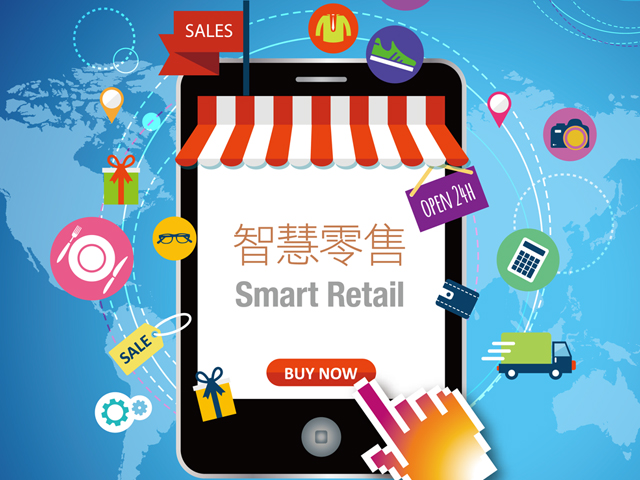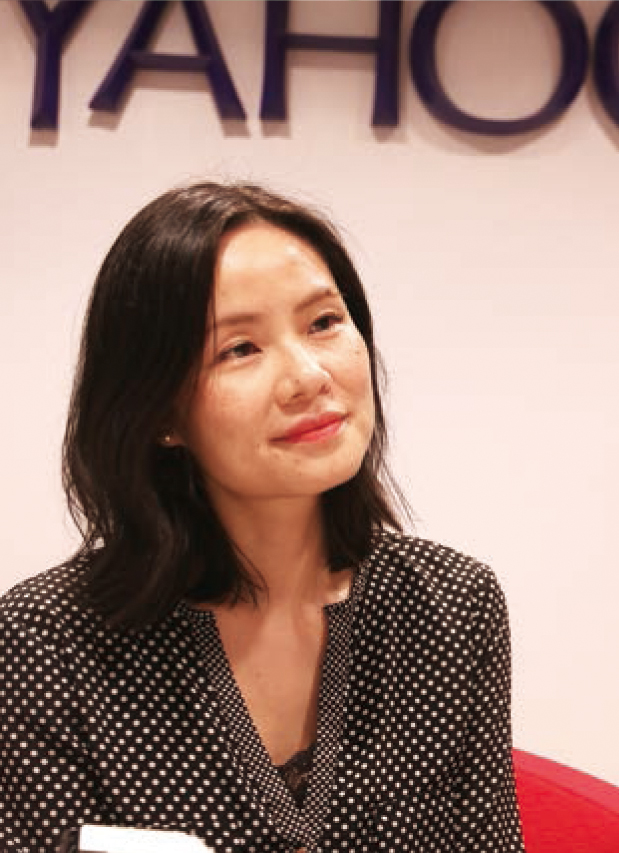Recording a 12.5% year-on-year drop in retail sales in Q1 2016, Hong Kong’s retail industry is evidently catching a downturn in a lackluster market. Some suggests that technology may be an exit for Hong Kong’s retail. If big data, the internet of things and innovative technologies are embraced, new business opportunities may emerge in the traditional retail industry.

Ricky Chu: Retail technologies create new sources of revenues
Ricky Chu, Chairman of Hong Kong Retail Technology Industry Association, has years of experience with the internet. He believes that merchants should adopt retail technologies as early as possible.es of revenues
Mobile payment: more than checkout convenience
 According to Chu, convenient payment methods, such as Octopus and credit cards, are never in shortage in the market. He, therefore, does not think mobile payment is making any major breakthrough in this aspect. The essence of mobile payment, instead, is data collection. By providing personal data during account registration, customers are indeed contributing to the big data of merchants.
According to Chu, convenient payment methods, such as Octopus and credit cards, are never in shortage in the market. He, therefore, does not think mobile payment is making any major breakthrough in this aspect. The essence of mobile payment, instead, is data collection. By providing personal data during account registration, customers are indeed contributing to the big data of merchants.
Big data: an analysis of consumer behavior
What do retailers do with their big data? Chu pointed out that while many merchants have established their own membership programs for a very long time, most of them only have a system without actually conducting big data analysis. Making good use of big data analysis can often help merchants turn the current adverse situation around. Chu said, “Let’s say you are operating two snack food shops, but none is doing well. Through big data analysis, you find out Shop A customers prefer Japanese products while Shop B customers are fond of Korean ones. You can therefore redistribute the product mix in the shops to improve the sales situation.”
Chu explained further with another example: A retailer once noted that their twenty-something customers usually put feminine hygiene products for their girlfriends in their shopping carts when they buy beers. “A product bundling opportunity is available in this situation, such as offering a free pack of tampons as a free gift for three bottles of beers. This is an informed sales strategy – instead of relying on intuition, big data analysis helps understand customer behaviors.”
IoT and VR
“IoT”, short for internet of things, is now also known as “IoE”, i.e. internet of everything. Since everything is connected to the internet, merchants are naturally offered with lots of intelligence.
In addition to connecting the online internet to the offline real world, O2O now has a new scope of business – virtual reality (VR). Chu said, “To quote an example, a couple looking for an overseas wedding venue can access 360-degree interactive videos of their venues using VR headsets.” VR will undoubtedly play an important role in the customer’s experiential journey and path to purchase.
e-commerce development: an inevitable trend
Chu reckoned we have now reached an era that all merchants should get used to technologies. There is no reason to decline the application of retail technologies. He said, “Certainly, the process of transformation is always difficult. Maturing technologies are, however, silver linings for merchants, as they offer opportunities for transformation, provide more confidence to their investments and shorten unnecessary detours.”

Tania Lau: No doubt about the advantages of e-commerce
Yahoo! Auctions, launched by Yahoo! Hong Kong in 2000, is a pioneer of C2C in Hong Kong. Tania Lau, Head of Marketing at Yahoo! Hong Kong, said that the potential of e-commerce is immeasurable.
About Yahoo Auctions
Lau said, “Initially, we only wanted to help local netizens solve problems by creating space for buyers and sellers to make contact.” She explained that the feature of auctions is to provide opportunity for buyers and sellers to bargain, enabling them to communicate and complete the transaction on their own so that the whole process is more meaningful.
The emergence of group purchase coincided with e-commerce’s entry into the 2.0 era in Hong Kong. Lau recalled that Groupon swept the world by storm as a start-up, and Yahoo Hong Kong launched Yahoo Deals in 2011.
For Yahoo Deals, Yahoo Hong Kong’s strategy is to strengthen its competitiveness by teaming up with several group purchase sites that have established a certain market share. As a result, its market share surpassed that of Groupon within half a year to become the platform with the largest market share in Hong Kong.
Online and offline are mutually complementary
Lau pointed out that Yahoo Deals set the Hong Kong people on the path of getting accustomed to online payment, and the increasingly sound security measures also helped gradually change their past conservative mentality. As the wheel of time runs fast, Yahoo Deals had to undergo adjustments, which led to the emergence of the new Yahoo Store. This service has the capacity to enable over a thousand brands to sell products online 24 hours a day.
Lau added that the costs of online sales, such as rent, are lower than those of traditional sales, and as the entry threshold is also lower correspondingly, businesses have more room to fine-tune their marketing strategies. With online sales, businesses can respond faster to customer feedback and more accurately allocate resources, thereby cutting back on wastage.
Getting ready for a new wave
Lau is confident that e-wallet services will propel e-commerce into the 3.0 era. It has been reported that Apple Pay will come to Hong Kong this summer, which Lau believes is symbolic of the arrival of the next wave. She said that mobile devices are obviously more popular today.
However, Lau noted that Hong Kong’s progress in e-commerce still lags behind other countries in the region. In many other regions outside Hong Kong, Yahoo generates far more profits from e-commerce than advertisements.
Lau noted, “Regardless of the outlook of retailing, there is no doubt about the advantages of e-commerce. It will be difficult for traditional sales to hold a candle to online sales in the future.” She further pointed out that Yahoo Hong Kong is currently preparing to integrate the development of omni-channel e-commerce by linking the online and offline information of each consumer to give them a better user experience.

Bobby Liu: New online shopping era focuses on customer experience
While the high-end consumer market has yet to make its best efforts to go online, Chow Tai Fook started to focus on developing its e-commerce business as early as in 2010.
At the beginning, the decision to hop onto the e-commerce bandwagon was driven by Bobby Liu, Executive Director of Chow Tai Fook Jewellery Group, when he observed that the market trend was moving towards younger consumers, and with so many e-commerce platforms beginning to mature, it was a good time for brand owners to launch their online business.
Ensuring consistency of online and offline quality
Liu said: “From knowing nothing initially, we now know how to display and sell our products, how to make use of customer service, how to understand the logistics and supply chains, and how to deliver goods perfectly to customers. We called this ‘e-fulfillment’. Through these processes, we continue to learn and improve.”
Liu said that regardless of online or offline, the brand’s products and services must be consistent, while the idea for the other aspects is not the same, “the most important thing is to implement omnichannel ‘e-fulfillment’ so that customers can enjoy the most personal experience.”
Some people have always felt that they should have their partners, family members or friends with them when shopping for luxury goods. Liu said, “Consumers often ask: won’t they be missing out on some experience if they buy products worth at least HK$10,000 online without touching them?" Liu then pointed out that many consumers will in fact gather information on the internet before shopping, but they may not make any purchases eventually. Therefore, as long as customers are willing to look for what they really want online or offline, it is a win-win for the brand.
Constantly reviewing and improving the e-commerce business
According to Liu, the company’s e-commerce development is divided into three stages. The first is starting up the business by building a dedicated team to learn the entire e-commerce operation from scratch, including display of goods, customer service, logistics and billing. The second is optimizing the entire operation through several key activities as the e-commerce system begins to mature.
Currently, the company is entering the third stage, which is to explore the use of Big Data to develop better strategies.
Liu noted that the company’s first stage coincided with Taobao’s launch of its B2C platform Tmall.com. Tmall.com provided a lot of resources for e-commerce operators to drive online user traffic. Hence, their sales performance was impressive at that time, but they were faced with logistics problems. He said, “We discovered that user ratings for the company had tumbled. The entire ‘e-fulfillment’, from product information, customer service operations to the logistics chain, was unsatisfactory. Because sales had been strong, we only thought of getting more business, but the logistics chain failed to provide the corresponding support. As a result, there was a logistical congestion.” After this incident, Chow Tai Fook immediately reviewed and streamlined the entire e-commerce process.
Mutual optimization between online and offline
Liu noted, “Our definition of O2O is how to give the customer an end-to-end experience of a brand’s services.” Also, in his view, O2O should be a ‘triple O’ concept, “the first ‘O’ is offline, i.e. the traditional brickand- mortar stores; the second ‘O’ is online, i.e. the online stores; and the third ‘O’ is others, i.e. the other emerging new forms of sales channels.”
In view of this, Chow Tai Fook constantly tries out new models to explore crosssectoral cooperation and development of new channels. Liu said that because the purpose of online channels is to make up for the inadequacy of offline channels, they may affect the shopper traffic at the brickand- mortar stores, but he believes that this is a process of mutual optimisation.
Liu admitted that the jewellery industry has its advantages. When customers shop for some high-priced products, they would take a look at the physical products at a brick-and-mortar store, because what virtual technologies such as AR and VR can show, at best, is only an image. He said, “How can we make the customer still go shopping at a traditional shopping mall after shopping online? This is a subject worthy of study.”




